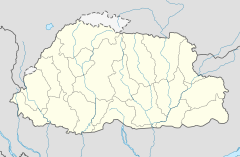User:ModernDayTrilobite/Kuenga Rabten Palace
| Kuenga Rabten Palace | |
|---|---|
| General information | |
| Architectural style | Dzong architecture |
| Location | Dragteng Gewog, Trongsa |
| Country | Bhutan |
| Coordinates | 27°24′51″N 90°30′44″E / 27.41406°N 90.51220°E |
| Completed | 1929 |
Kuenga Rabten Palace is a palace in the Trongsa District of Bhutan. It was established by Jigme Wangchuck, the second king of Bhutan, as a winter palace.
Geography
[edit]Kuenga Rabten Palace is in the Dragteng Gewog of Trongsa District. It sits about 24 kilometers south of the town of Trongsa, and is positioned on a hill overlooking the Sarpang-Gelephu-Trongsa Highway.[1]
History
[edit]Jigme Wangchuck commissioned the Kuenga Rabten Palace in 1929. The construction was overseen by his father-in-law, Dasho Jamyang.[2][3] The primary function of the building was to serve as a residence for Jigme Wangchuck and his first wife, Ashi Phuntsho Choden; however, parts of the building were also used to store grain and to house soldiers.[1] This palace was one of the king's favorite residences, and it was the location where he died in 1952.[4]
Since Jigme Wangchuck's death, Kuenga Rabten Palace has been maintained by the monastic community of Trongsa District; as of 2014, around fifty monks lived in the palace. The palace also stores books on behalf of the National Library of Bhutan, and hosts archery matches on its grounds.[1]
Architecture
[edit]Kuenga Rabten Palace is a three-floor dzong constructed from wood and stone. The palace is centered around a chapel known as Sangye Lhakhang, which is the largest room on the top floor; adjoining the chapel are rooms that were once the private residence of Jigme Wangchuck and Phuntsho Choden. The king's room is preserved in its original form, while the queen's room has been repurposed as an office for the monks who now maintain the palace. Since the death of Jigme Wangchuck, the ground floor has been disused, while the second floor holds classrooms for the monks.[1]
There are a number of paintings throughout the palace. The most notable are a depiction of the 35 Buddhas of Compassion, as well as images of Shakyamuni Buddha in the central chapel.[1]
References
[edit]- ^ a b c d e Sangay Thinley (2014-06-13). "Kuenga Rabten Palace". Bhutan Cultural Atlas, Centre for Bhutan Studies. Retrieved 2021-12-02.
- ^ Lham Dorji (1998). Wangchuck Dynasty: 100 Years of Enlightened Monarchy in Bhutan (PDF). Center for Bhutan Studies. p. 33. ISBN 978-99936-14-51-7.
- ^ Sonam Chophel. "The Kuenga Rabten Palace was built in 1929, when King Jigme Wangchuck was 24 years old". Retrieved 2021-12-02.
- ^ Lham Dorji, p. 46

